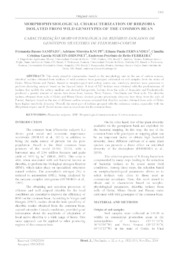Morphophysiological characterization of rhizobia isolated from wild genotypes of the common bean.
Morphophysiological characterization of rhizobia isolated from wild genotypes of the common bean.
Author(s): SAMPAIO, F. B.; KNUPP, A. M.; FERNANDES, E. P.; MARTIN-DIDONET, C. C. G.; FERREIRA, E. P. de B.
Summary: This study aimed to characterize, based on the morphology and on the use of carbon sources, rhizobial isolates obtained from nodules of wild common bean genotypes cultivated on soil samples from the states of Goiás, Minas Gerais and Paraná. Based on morphological and carbon source use, similarity matrixes were generated to perform clustering analysis based on the Jaccard index. A total of 523 isolates were obtained with the predominance of isolates that acidify the culture medium and showed fast growth. Isolates from the soils of Araucária and Prudentópolis produced a greater amount of mucus than those from Jussara, Nova Veneza, Uberlândia and Unaí soils. The rhizobia isolates obtained from soils of Goiás and Minas Gerais showed greater phenotypic diversity than those from the soils of Paraná. Analysis based on the use of different carbon sources revealed that rhizobia isolates obtained from soils of Goiás have higher metabolic diversity. Overall, the most part of isolates grouped with the reference strains, especially with the Rhizobium tropici and R. freirei strains used as inoculants for the common bean.
Publication year: 2016
Types of publication: Journal article
Unit: Embrapa Rice & Beans
Observation
Some of Embrapa's publications are published as ePub files. To read them, use or download one of the following free software options to your computer or mobile device. Android: Google Play Books; IOS: iBooks; Windows and Linux: Calibre.
Access other publications
Access the Agricultural Research Database (BDPA) to consult Embrapa's full library collection and records.
Visit Embrapa Bookstore to purchase books and other publications sold by Embrapa.

